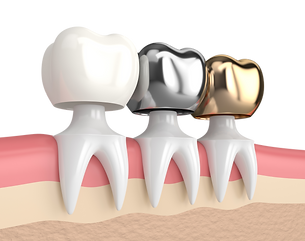
Crowns
Dental
Gentle Dental Will Make Sure Your Crowns Look Great!
If you want to restore your smile, we can help you here at Altamesa Dental. Our caring team specializes in restoring smiles to the fullest! A dental crown is a tooth-shaped “cap” that is cemented onto your natural tooth, resulting in long-lasting and fully functional tooth restoration.
They are an excellent choice of restoration for many types of dental issues, such as:
-
To strengthen and protect a decayed tooth, e.g. one with decay too large to be repaired by a filling
-
To restore a badly worn down, chipped or cracked tooth
-
To change or restore the shape, size or color of a tooth
-
To complete a larger dental restoration, such as a dental implant or bridge

Dental Crown Materials
Crowns can be made of ceramic (porcelain-based), porcelain fused to metal, gold alloys, and base metal alloys. There are strengths and disadvantages to each type of material.
1. Base Metal Alloys are very strong and highly resistant to corrosion and wear, as well as gentle to opposing teeth. A base metal alloy crown typically requires the least amount of tooth structure to be removed.
2. Gold Alloys adhere strongly to the tooth structure and are highly biocompatible with gum tissue. It is resistant to wear and fracture and does not wear away opposing teeth.
3. Porcelain Fused to Metal (PFM) crowns provide good strength and seal to the teeth, preventing leakage and decreasing recurring tooth decay. A moderate amount of tooth structure must be removed, but PFM crowns offer a stronger restoration than porcelain alone and are quite durable and strong. However over time, dark grey or black lines can begin to appear at the gum line as the metal base begins to show through.
4. Ceramic is especially recommended for restoring front teeth due to their high natural appearance. Porcelain crowns can be shade-matched exactly to the shade of your other teeth, and unless damaged are highly resistant to staining. More tooth structures often must be removed for porcelain crown restorations, and because the material is not as durable as the other options it is not recommended for teeth that sustain heavy biting and chewing.
The Procedure:
During the first visit,
our dentists will numb the area and shape the tooth so that a crown can fit over it. They will take an impression, which will be sent to a dental lab where the crown is created to beautifully match your other teeth. He will fit you with a temporary crown to protect your tooth while the crown is being made, which generally takes about two weeks.
The Procedure:
On the second visit,
our dentists will thoroughly inspect the permanent crown to ensure the correct size, shape and color. They will then remove the temporary crown and cement the permanent crown into place, again checking to be sure that fit, bite and aesthetics are correct. You will be given care instructions to ensure that your crown lasts a very long time. With proper care, dental crowns can last 10-20 years or even a lifetime!
.png)

